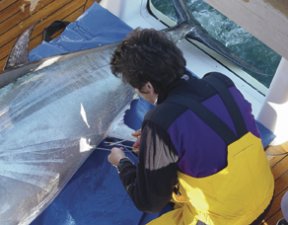Where Tuna Go: Atlantic fish mix for feeding, not spawning
The largest high-tech tag study yet of Atlantic bluefin tuna suggests that two groups mix on feeding grounds but spawn on opposite sides of the ocean. This finding indicates that fishing regulations need to change, say the researchers who tagged and tracked hundreds of the fish.

Bluefin tuna counts in the western Atlantic plummeted decades ago and haven’t recovered, despite conservation measures, says Barbara Block of Stanford University. Estimates are that 25,000 fish remain. Block and her colleagues say that their new evidence supports the idea that tuna populations travel widely but spawn only at the edge of the continental shelf in the Gulf of Mexico or at a site in the Mediterranean Sea.
“The data’s very exciting,” comments Molly Lutcavage of the University of New Hampshire in Durham, who leads another group of tuna taggers.
A big advance in studying tuna came with the development of electronic tracking devices. In the April 28 Nature, Block and her colleagues report information from 330 Atlantic tuna tracked electronically for up to 5 years.
A report from this project in 2001, with data from about 50 fish, said that the tuna swam unexpectedly long distances, even crossing the Atlantic (SN: 8/18/01, p. 101: Available to subscribers at Smart tags show unexpected tuna trips).
The new work continues to support the idea that fish from the east and west mingle in feeding grounds. The team now reports that 26 tuna tagged in the western Atlantic migrated all the way to the Mediterranean.
When spawning time comes, though, tuna seem to return to a home base, says Block. Adults turned up at the two known spawning sites, and several bore tags with multiyear data showing that the fish had returned to the area they visited the previous season.
The adult fish picked up for tagging in the warm Gulf waters were more fragile than those caught elsewhere. Although tuna fishing with long, baited lines has already been banned in the spawning area, fleets looking for other species sometimes accidentally catch the tuna and then release them. Weak fish don’t survive that handling. Block now proposes closing the area to all longline fishing during tuna spawning.
John J. Magnuson of the University of Wisconsin–Madison, who chaired a National Research Council committee on Atlantic tuna in 1994, says that the little evidence available then tilted against fidelity to specific breeding grounds. The new paper and other evidence, he says, have changed his opinion.
The case for site fidelity is still “tricky,” cautions François Royer of the Center for Mediterranean and Tropical Fisheries Research in Sète, France.
Lutcavage agrees that too many questions remain for firm conclusions on spawning-site loyalty. Many of the adult tuna she’s tagged off New England haven’t yet turned up in either of the known breeding sites, she says. Perhaps other sites remain to be discovered, or it may be that tuna don’t breed every year.






